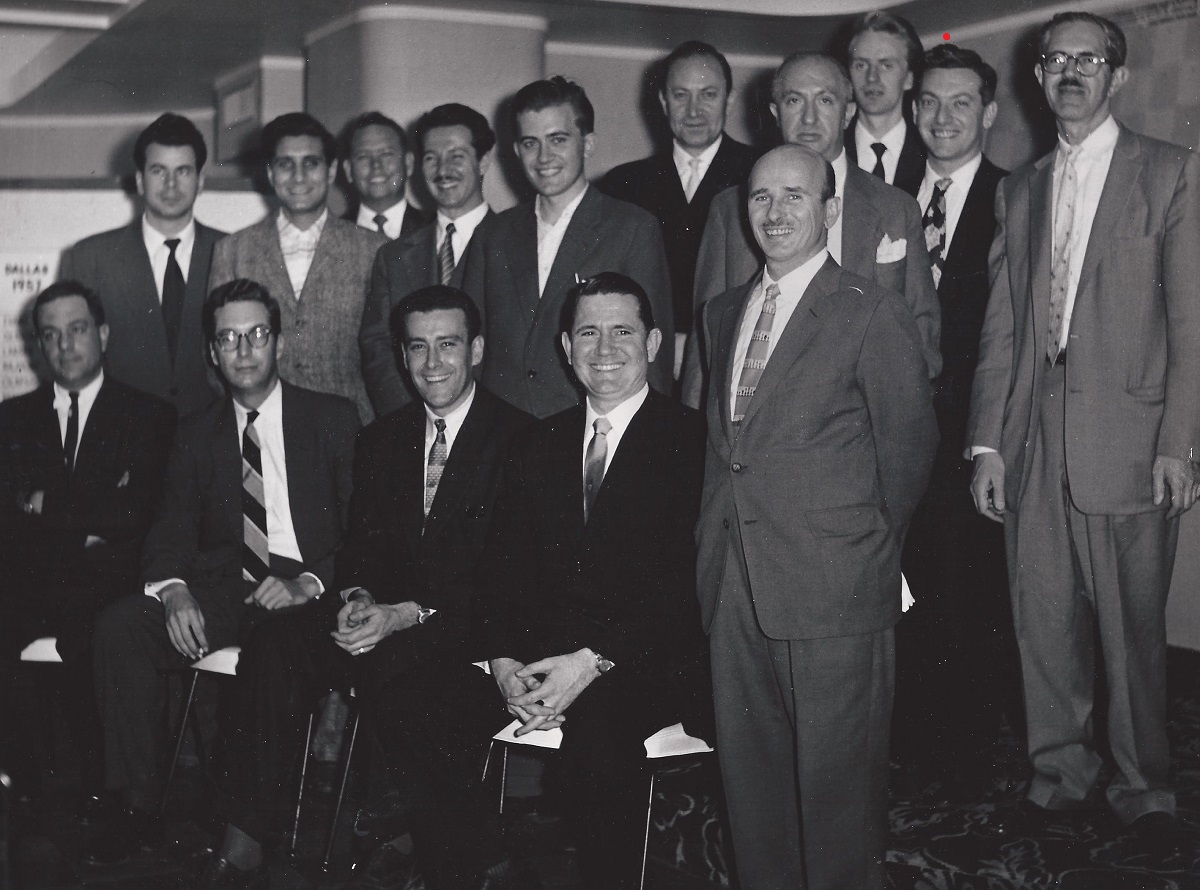
Edward Winter

Dallas, 1947 (see C.N. 8036 below)
The recent death of D.A. Yanofsky prompts us to record here two remarks by world champions. Firstly, Alekhine’s posthumous book Gran Ajedrez reproduced photographically part of his annotations (in English) to the famous game Yanofsky (aged 14) v Dulanto, Buenos Aires, 1939. At move 22 Alekhine wrote:
‘The whole little game is characteristic of the incisive style of the young Canadian, who was practically the only revelation of the Buenos Aires Team Tournament.’
In the introduction to Yanofsky’s book Chess the Hard Way! (London, 1953) Euwe, for his part, declared:
‘Considering his youth and his talent, I have no doubt that Abe Yanofsky will one day belong to the strongest of the strong ones, and many of my colleagues share this opinion.’
Chess the Hard Way! is, we believe, one of the best autobiographical games collections. Today, alas, it seems all but forgotten, as does Yanofsky’s 1957 treatise on the phase for which he was the most famed, How to Win End-Games.
Regarding Yanofsky v Dulanto see also C.N. 12052. Below is an inscription by Yanofsky in our copy of his fine autobiographical work Chess the Hard Way! (London, 1953):
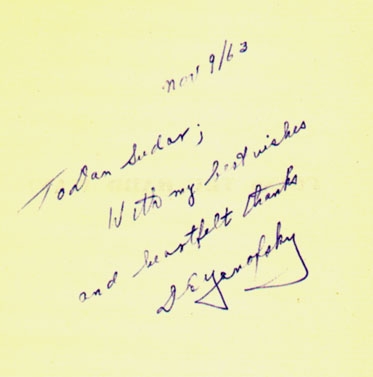
The Canadian press of the late 1930s had many articles about the prodigy Yanofsky, such as the following on pages 1 and 8 of section three of the Toronto Star Weekly, 8 May 1937:
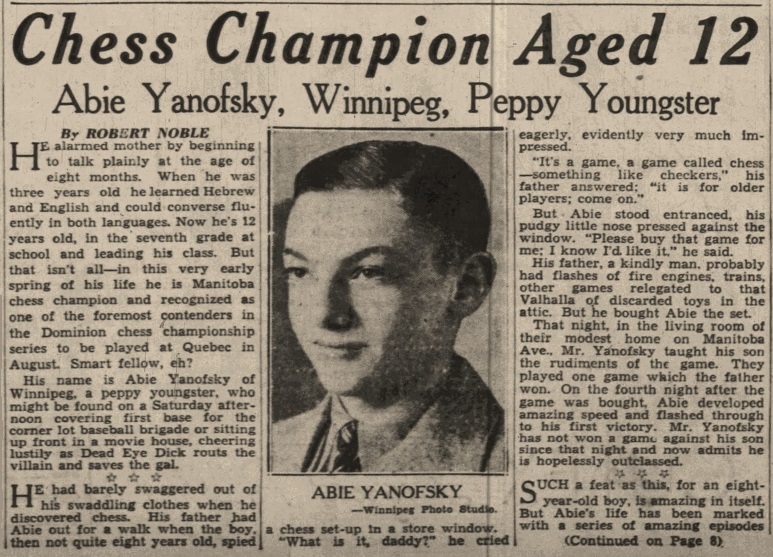

From page 39 of Chess the Hard Way! by D.A. Yanofsky (London, 1953) comes this passage regarding the 1939 Olympiad in Buenos Aires:
‘By winning the next two games I scored 9½ points out of a possible 10 and was awarded a silver cigarette holder inscribed: “Mejor Jugador del Torneo” [best player of the tournament].’
Times have certainly changed, as it is hard to imagine that organizers today would offer a 14-year-old boy anything smacking of smoking.
(3003)
See Chess and Tobacco and From Former Times.
Jonathan Berry (Nanaimo, BC, Canada) notes that a prodigy not yet mentioned in our recent series [he was subsequently added to Chess Prodigies] is Daniel Abraham (Abe) Yanofsky (see page 245 of A Chess Omnibus). Here we give a brief item from page 47 of CHESS, 14 October 1938:
‘Master Abie [sic] Yanofsky
Canada’s boy wonder has a dual right to the above title now. Only 14 years old, he had to beg time off from school to compete in the Canadian national championship, yet beat three former Canadian champions, Blumin, Belson and Martin, in consecutive games. Against weaker players he proved inconsistent, Maurice Fox, of Montreal, winning the title.
The Daily Mirror thought he was a girl, “Just a little schoolgirl” ran their headline. “She finished equal fourth ...” their report.’
(3881)
The CHESS report quoted in C.N. 3881:

From page 25 of the Daily Mirror, 28 September 1938:

Later the same day, the London Evening News (page 6) had this:
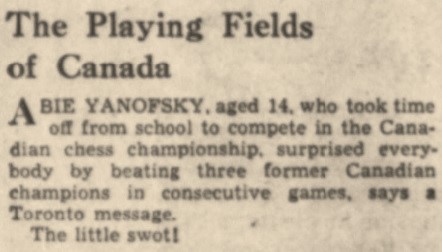
At that time, ‘Abie’ Yanofsky was a normal spelling of his name.
(12159)
In C.N. 858 [written in 1984] we suggested that that there was a striking physical resemblance between Abe Yanofsky (in a photograph published on page 1 of the October 1942 CHESS) and Anatoly Karpov. A subsequent item (C.N. 1070) quoted the view of B.H. Wood (Sutton Coldfield, England):
‘Frankly I don’t detect the least resemblance to Karpov. Of course I’ve met both perhaps 100 times’.
Here is the Yanofsky photograph, so that readers can decide for themselves:
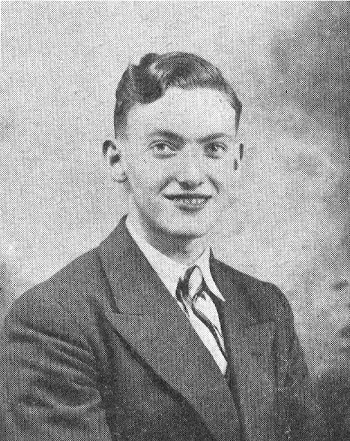
(Kingpin, 2001)
Geoffrey Egan (Edmonton, Canada) writes:
‘I was delighted to see you take to task the egregious Chess Panorama by W. Lombardy and D. Daniels in C.N. 900. Might I offer another example of outright blunder and fallacy contained in that lamentable volume? On page 161 the authors state:
“... Fischer scored his unprecedented eleventh straight victory in the 1963-64 US Championship, the only time anyone has ever made a clean sweep in any tournament with a national title at stake.”
This, of course, is just nonsense. To take but one example, at both Halifax in 1943 and Montreal in 1959 Abe Yanofsky scored +11 –0 =0 in the Canadian Championships of those years. (He also scored +5 –0 =0 in the 1936 Canadian Senior Boys’ Championship.) Presumably these all qualify as tournaments with a national title at stake. I am sure that many other examples could be found for other countries. Of course, it is possible that Lombardy and Daniels meant American national titles; even then the statement must be considered dubious, although I don’t have at hand a complete list of all American titles (National, Women’s, Junior, etc.). Fischer’s domination of American chess was surely impressive enough without the need to make claims that are patently bogus to enhance it.’
(1509)
Dominique Thimognier (St Cyr sur Loire, France) offers an addition to our Chessy Words feature article: chessicide. He points out that the word occurs at the website of the Fédération québécoise des échecs, in a report (no original source given) on a tournament held in Canada in 1956. Can a reader provide us with an exact citation for ‘chessicide’ from that time?
(4405)
From Stephen Wright (Vancouver, Canada):
‘I cannot positively identify the source of “chessicide”, but I strongly suspect that it is in the tournament book produced by Abe Yanofsky. The 1st Canadian Open was reported on in the August-October 1956 (combined) issue of Canadian Chess Chat, pages 8-14, in an article by Yanofsky, who had just taken over as editor of the magazine. The introductory text in this article is identical to the first two italicized paragraphs on the website of the Fédération québécoise des échecs. The rest of the Canadian Chess Chat article (covering the individual rounds) is shorter than, and different from, the text on the website, but there is mention that a tournament book, to contain the hundred best games, was in preparation.’
(4432)
An item in Chess Autographs:
Below is a page from one of our copies of Chess Secrets I Learned from the Masters by Edward Lasker (New York, 1951), inscribed by the players at Hastings, 1951-52 (plus Sämisch, a participant in the Premier Reserves tournament):
In order: L. Schmid, D. Yanofsky, L. Barden, D. Hooper, H. Golombek, G. Abrahams, A.R.B. Thomas, S. Popel, F. Sämisch, S. Gligorić and J.H. Donner.
Below is Robert G. Wade’s complete entry on page 240 of Who’s Who in New Zealand (Wellington, 1951):
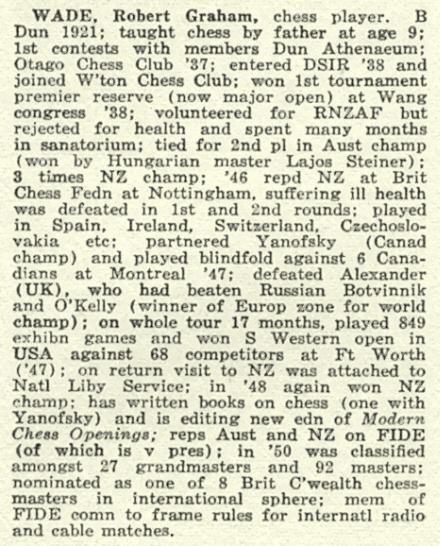
The bibliographical references may seem surprising at first sight, but page vii of Chess the Hard Way! by D.A. Yanofsky (London, 1953) acknowledged Wade’s collaboration. On page v of the eighth edition of Modern Chess Openings (London, 1952) the Editor, Walter Korn, related in detail the extent of the contribution by Wade.
(7295)
Courtesy of John Donaldson (Berkeley, CA, USA), below is a photograph from the archives of Jacqueline Piatigorsky:
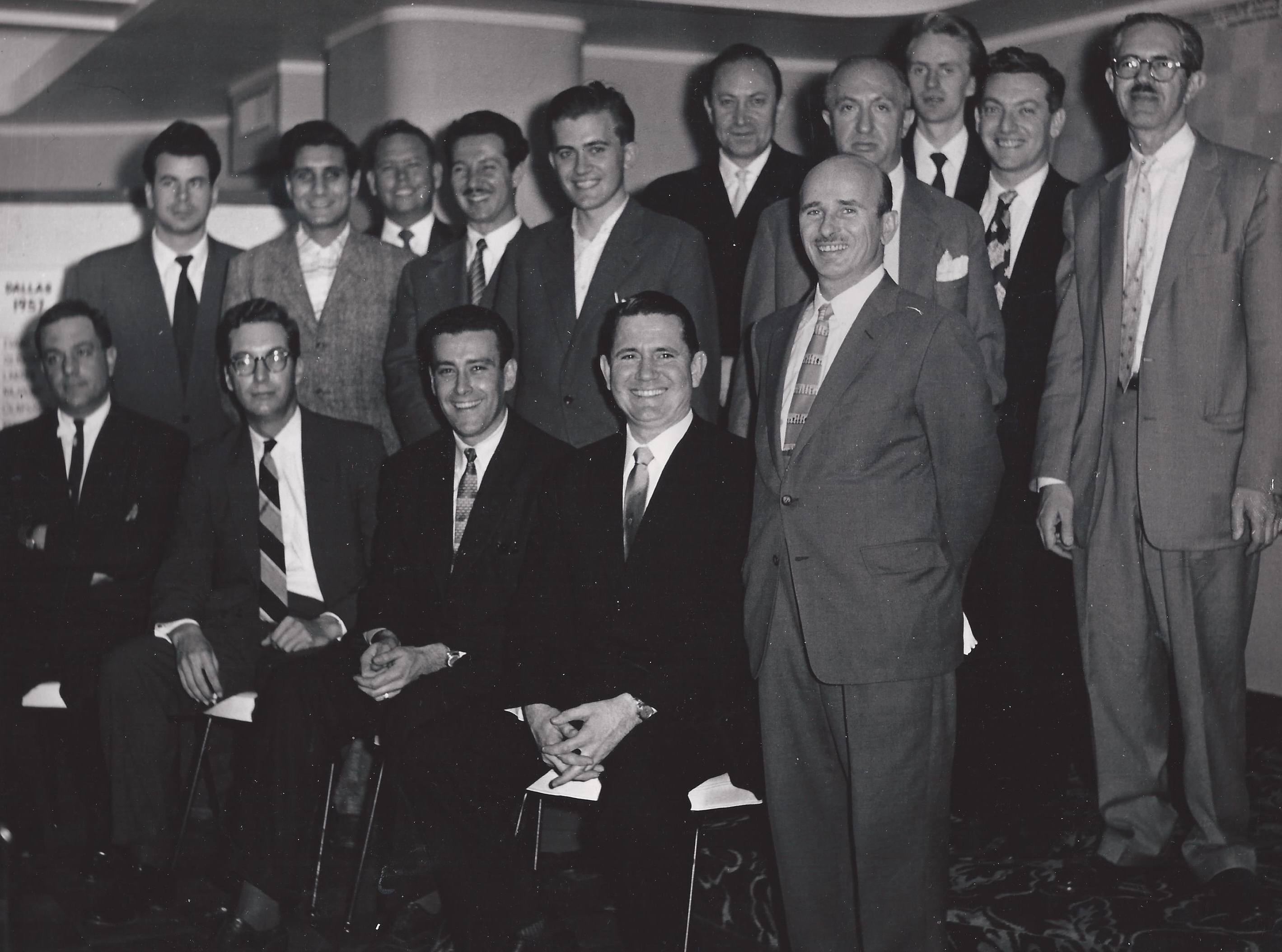
Mr Donaldson adds that the photograph was published on page 7 of Chess Life, 20 January 1958 with the following information:
Left to right: front row: Emile Gilutin and Fred Tears (the tournament organizers), Landrum (public relations [no forename given]), Jerry Spann (USCF President), Samuel Reshevsky.
Back row: Pal Benko, Larry Evans, Kenneth Smith, Svetožar Gligorić, Bent Larsen, László Szabó, Miguel Najdorf, Friðrik Ólafsson, Daniel Yanofsky and Isaac Kashdan (tournament director).
(8036)
From page 78 of The Times Winning Moves 2 by Raymond Keene (London, 1996):
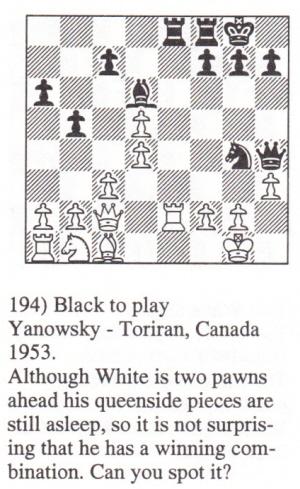
From page 57 of The Times Winning Moves by Raymond Keene and Byron Jacobs (London, 2003):
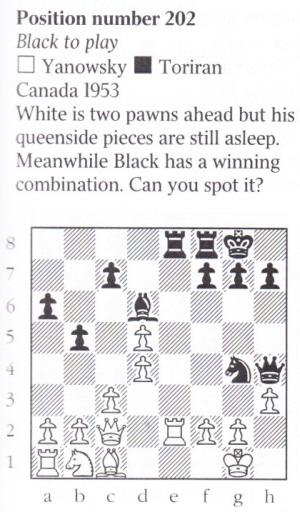
From Dan Scoones (Port Coquitlam, BC, Canada):
‘In citing a chess position it requires a very special talent to garble not only the venue and the date but also the surnames of both players – in other words, everything of significance apart from the actual position and the subsequent moves.’
Mr Scoones draws attention to the passage below from page 116 of Chess the Hard Way! by D.A. Yanofsky (London, 1953). ‘Hastings’ refers to the 1946-47 tournament, in which he came fourth.
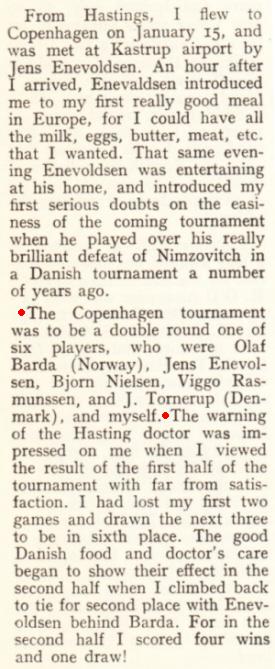
We note ‘Yanofsky-Toriran, Canada, 1953’ on page 203 of the Encyclopaedia of Chess Middlegames (Belgrade, 1980), but the full game (Yanofsky v Tornerup, Copenhagen, 1947) was published on page 172 of CHESS, March 1947:
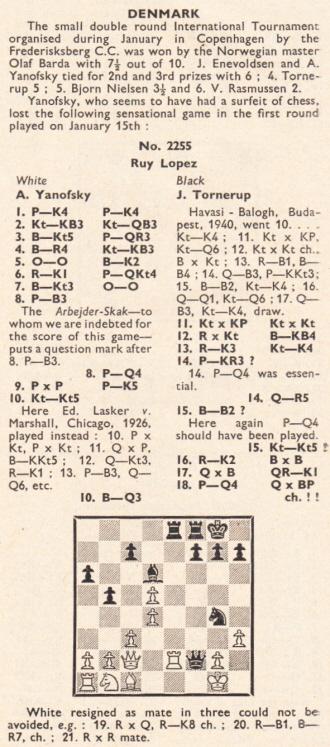
1 e4 e5 2 Nf3 Nc6 3 Bb5 a6 4 Ba4 Nf6 5 O-O Be7 6 Re1 b5 7 Bb3 O-O 8 c3 d5 9 exd5 e4 10 Ng5 Bd6 11 Nxe4 Nxe4 12 Rxe4 Bf5 13 Re3 Ne5 14 h3 Qh4 15 Bc2 Ng4 16 Re2 Bxc2 17 Qxc2 Rae8 18 d4 Qxf2+ 19 White resigns.
(8175)
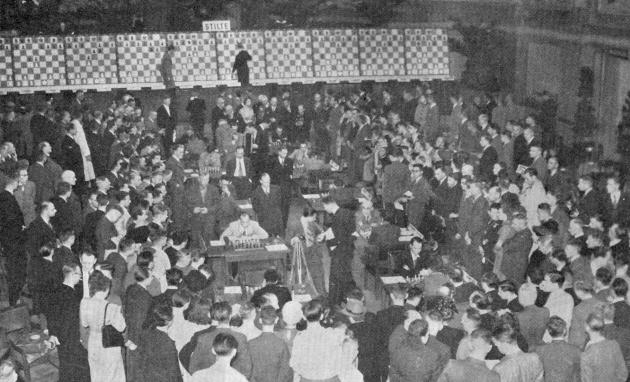
From Henk Smout (Leiden, the Netherlands), further to C.N.s 6370 and 6384:
‘In this first-round photograph (also published opposite page 32 of the book 20 grote denkers binnen Neêrlands grenzen by Peter van Foreest) the master furthest away in the left-hand row is Smyslov, playing against Vidmar. Then come Steiner, Botvinnik, Denker and (in the foreground with his back to the camera) Guimard. In the right-hand row, the first (front) master is Christoffel (back to camera), in play against O’Kelly. At the next board is Kottnauer, playing against Bernstein. Then come Yanofsky, Kotov at the board with Stoltz and, finally, Flohr. Standing behind Flohr seems to be Tartakower and behind him, on the left, Kmoch. Standing behind Botvinnik’s board, with his hands in his pockets, is Najdorf, and behind him is Euwe. Between the boards of Botvinnik and Denker, Lundin is standing on the left, and Szabó on the right. That leaves Boleslavsky. He is to the right of Najdorf and behind Szabó.
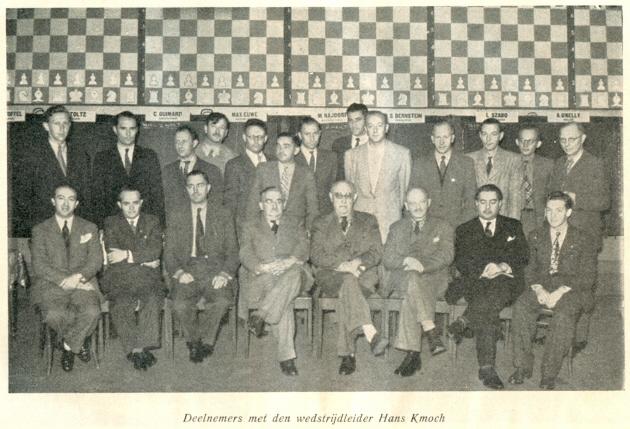
The second photograph, taken before the start of the fourth round, was given opposite page 80 of van Foreest’s book, which mentions all the names. Seated, from the left: Najdorf, Flohr, Euwe, Vidmar, Bernstein, Tartakower, Guimard and Yanofsky. Standing, from the left: Smyslov, O’Kelly, Boleslavsky, Steiner, Botvinnik, Kotov, Szabó, Kottnauer, Denker, Lundin, Stoltz, Christoffel and Kmoch.’
In the first photograph Guy Brunet (Montreal, Canada) suggests that the figure on the left watching Botvinnik’s game is Alexander Rueb.
(6425)
Regarding visits by Yanofsky to Rubinstein after the Second World War, see Akiba Rubinstein’s Later Years.
Olimpiu G. Urcan (Singapore) provides a photograph courtesy of the Hulton Archive:
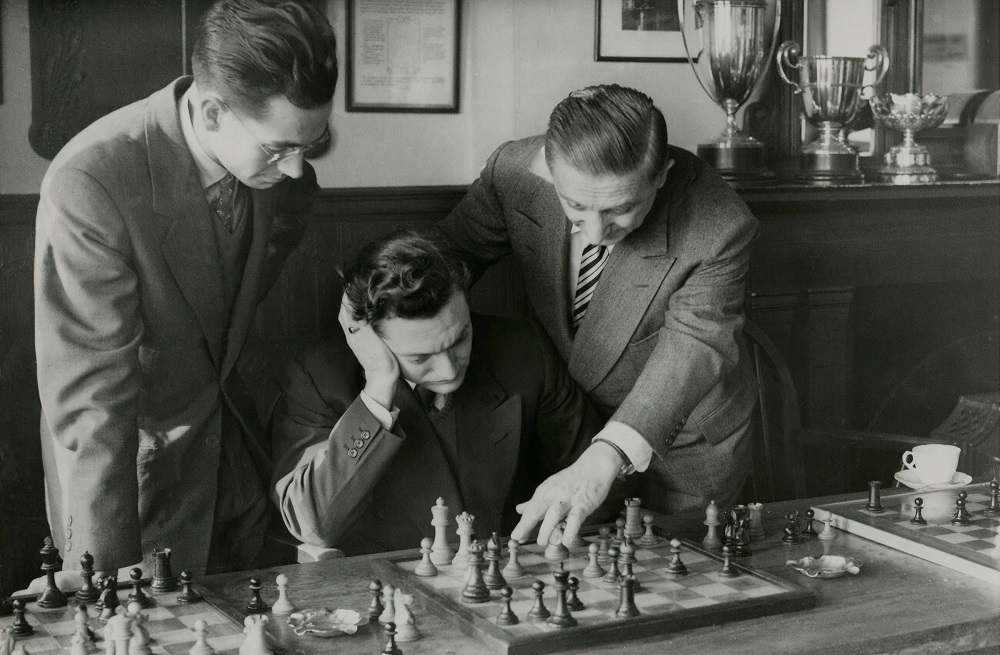
Hastings, 1952-53
On Yanofsky’s left is Edward Lasker. In the Alamy database, which gives 30 December 1952, the third player is identified as ‘Mr James Mora (Spain)’, i.e. Jaume/Jaime Mora Corbera of Catalonia, who won the Premier Reserves A tournament.
To the Archives
for other feature articles.
Copyright Edward Winter. All rights reserved.